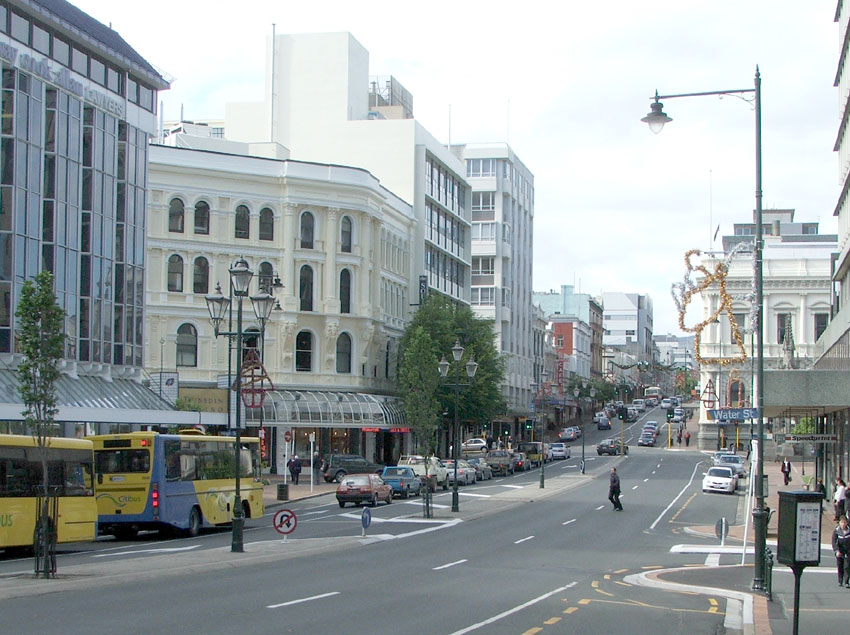14 Reduced Public Transport fares
14.0.1 Description
The pricing of public transport (PT) affects mode choice. Lowering PT fares can result in a shift from the use of the private car (or other means of transport) to PT alternatives; increasing PT fares have the opposite effect. An example of a fare change policy is the 50% reduction in PT fares in New Zealand, initially Apr-Jun 2022.
14.0.2 Type of travel affected
People attracted to PT tend to be commuting to/from work (y%), education (x%) or more generally when not carrying a heavy load or requiring multiple destinations (??%). They tend to live within ‘x’ km of their destination. A shift to PT will have its greatest impact on congestion during peak hours but a more widespread shift to PT is required to achieve a large vkm reduction.
14.0.3 How travel and emission effects can be measured and modelled (include long-run effects)
Travel cost is typically measured as generalized transport costs (GTC), being a combination of fares and the attributes of a complete journey converted to equivalent dollars. Only the fare component is discussed in this section – the non-fare components of GTC are discussed within the accompanying PT Services section. Note, findings suggest that riders are more sensitive to service change than to fare change.
The emissions effect of fare changes is the result of three interactions: the change in riders; the change in private light vehicle use (resulting from people changing modes); and the change in emissions resulting from any substituted PT vehicle and private light vehicle use.
The change in riders is measured as a fare elasticity of demand.
Fare elasticities depend on travel mode, type of area, analysis horizon, type of fare change and current fare levels, as well as the specific local circumstances, including the quality of service provided in each mode or combination of modes. In general, communities with high proportions of transit-dependent residents will show less response to fares.
Fare elasticity also depends on the magnitude, sign and timespan of the fare change. Long-run (5-10 years) fare elasticity is higher than the static or short-run elasticity, suggesting that travelers gradually adjust their travel behaviour to price changes.
In general, larger fare increases produce higher values of elasticity than lower increases. Off-peak elasticity values can be about twice the peak values, with slightly greater variation for suburban rail than the other modes.
Bus fare elasticity averages around −0.4 in the short run (ie, 10% decrease in fares results in a 4% increase in ridership), −0.56 in the medium run and −1.0 in the long run; metro fare elasticities average around −0.3 in the short run and −0.6 in the long run, and local suburban rail around −0.6 in the short run. Although, there are variations by region and by type of city.
Not all the change in PT ridership results in a mode shift to/from private light vehicles. Typically, a quarter to half of increase PT ridership represents a reduction in light vehicle mileage although this is not always the case: in London (UK), car use is almost independent of bus and underground fares.
The CO2e effect is measured by the change in private and public vehicle emissions. A fare reduction leading to a mode shift to electric PT from private light ICE vehicles would reduce emissions but any reductions would likely be less for other mode permutations, especially if more PT services was an accompanying policy to the fare reduction.
An extreme form of fare reduction is to make PT fare-free. Such cases effectively provide an upper limit to the effect of fare reductions, in turn putting focus on the other factors of PT demand. Outcomes suggest that all public transport systems that eliminate fares experience initial (and occasionally sustained) ridership surges—usually at the expense of walking trips and bicycle trips more than driving trips—however there is little evidence that, as a result of fare elimination, there is less automobile traffic, significant mode shifts to public transport, or less traffic congestion (Hess, 2017).
Not necessarily a change in the fare applied, research points to simplification and unification of the fare scheme as substantially contributing to the attractiveness of PT (Kholodov et al., 2021). See also Integrated Ticketing.
Extensive summaries of fare elasticities are provided by Litman, T. (2021) and Dunkerley et al., (2018).
14.0.4 Secondary impacts
In most cities around the world, funding via fares, is usually only 30-80% of PT operating costs (Wong & Hensher, 2021). Lowering fares reduces PT operators’ and transport authorities’ revenues requiring either higher public subsidies or a decrease in the level of services. Increasing fares does not guarantee increased revenues due long-term elasticities of PT to price increasing above -1 in some cases.
Methods used to reduce or mitigate any revenue decline include higher resident income taxes and higher local taxes in Aubagne, France, and combining these taxes with free fares restricted to residents only in Tallinn, France.
PT pricing measures may result in an increase of PT ridership and a reduction in the use of personal motorised transport and reverse the related adverse impacts; reducing congestion, reducing air pollution, freeing-up public space to the benefit of alternative transport modes.
Evidence from Tallinn shows that the mobility of low-income residents improved due to the implementation of free PT. Inequity also applies in that car ownership is biased towards by income, working status and age and car ownership, in turn, is also significantly related to overall emissions.
There is strong evidence from Aubagne, Dunkirk (France) and many Polish cities that fare abolition can help to increase the quality of collective transport, generating very high passenger satisfaction. The increased use of PT under a fare-free programme places collective transport on political agendas and strengthens public support for higher operation and investment subsidies. In Dunkirk, fare abolition has been part of a large-scale urban renewal programme aimed at halting the city’s post-industrial decline.
Evidence from London suggests that public transport use is highly sensitive to car costs. People are more likely to shift from using their private car to using public transport when the price of car usage is increasing, rather than decreasing their cost of travel by using public transport.
There are cases where free fares lead to overcrowding and increases in vandalism.
Greater reliance on PT risks greater disruption to travel during times of pandemics.
14.0.5 Key Information sources
Alkharabsheh, A., Moslem, S., & Duleba, S. (2019). Evaluating Passenger Demand for Development of the Urban Transport System by an AHP Model with the Real-World Application of Amman. Applied Sciences, 9(22), 4759. https://doi.org/10.3390/app9224759
Weights for PT attributes derived from a survey, ranging from frequency (highest) to distance to stop (lowest).
Borjesson, M., Fung, C. M., & Proost, S. (2017). Optimal prices and frequencies for buses in Stockholm. Economics of Transportation, 9. https://www.researchgate.net/publication/312409003_Optimal_prices_and_frequencies_for_buses_in_Stockholm
Brand, C., & Preston, J. M. (2010). ‘60-20 emission’—The unequal distribution of greenhouse gas emissions from personal, non-business travel in the UK. Transport Policy, 17(1), 9–19. https://doi.org/10.1016/j.tranpol.2009.09.001
There is a huge range in emissions, with the highest 20% of emitters producing 61% of emissions. This ‘60-20 emission’ rule is surprisingly similar across units and scale of the analysis.
Cass, N., & Faulconbridge, J. (2016). Commuting practices: New insights into modal shift from theories of social practice. Transport Policy, 45, 1–14. https://doi.org/10.1016/j.tranpol.2015.08.002
The availability of the constituent elements of bus- and cycle-commuting practices is crucial for modal shift to occur, but they are often absent.
Dunkerley, F., Wardman, M., Rohr, C., & Fearnley, N. (2018). Bus fare and journey time elasticities and diversion factors for all modes. RAND Europe and SYSTRA. https://www.rand.org/content/dam/rand/pubs/research_reports/RR2300/RR2367/RAND_RR2367.pdf
Report prepared for the UK Department for Transport, providing evidence on bus fare and journey time elasticities and diversion factors for all modes.
Gates, S., Gogescu, F., Grollman, C., Cooper, E., & Khambhaita, P. (2019). Transport and inequality: An evidence review for the Department for Transport (p. 72). NatCen Social Research. https://assets.publishing.service.gov.uk/government/uploads/system/uploads/attachment_data/file/953951/Transport_and_inequality_report_document.pdf
Includes "policies that make transport more affordable (such as concessionary fares/subsidies) can be an effective way to help people living in poverty to access and maintain work. However, careful consideration is needed to ensure these help those most in need".
Hess, D. B. (2017). Decrypting fare-free public transport in Tallinn, Estonia. Case Studies on Transport Policy, 5(4), 690–698. https://doi.org/10.1016/j.cstp.2017.10.002
Example of fare-free policy that did not achieve a large ridership change.
ITF (2021) Transport Climate Action Directory – Public transport pricing. https://www.itf-oecd.org/policy/public-transport-pricing
A summary of PT pricing effects (some of which is repeated above)
Kholodov, Y., Jenelius, E., Cats, O., van Oort, N., Mouter, N., Cebecauer, M., & Vermeulen, A. (2021). Public transport fare elasticities from smartcard data: Evidence from a natural experiment. Transport Policy, 105, 35–43.
An example of short-term elasticities from a ‘natural experiment’.
Kingsley, D., & Urry, J. (2013). After the Car. Wiley.https://www.wiley.com/en-us/After+the+Car-p-9780745658735
The authors look at changes in technology, policy, economy and society, and make a convincing argument for a future where, by necessity, the present car system will be re-designed and re-engineered.
Litman, T. (2021). Transit Price Elasticities and Cross—Elasticities (pp. 37–58). https://www.vtpi.org/tranelas.pdf
An extensive summary of own- and cross-price PT elasticities.
Wong, Y. Z., & Hensher, D. A. (2021). Institutional reform in the bus and coach sector for a new decade.
A summary of the 2019 Thredbo conference on land passenger transport.





























